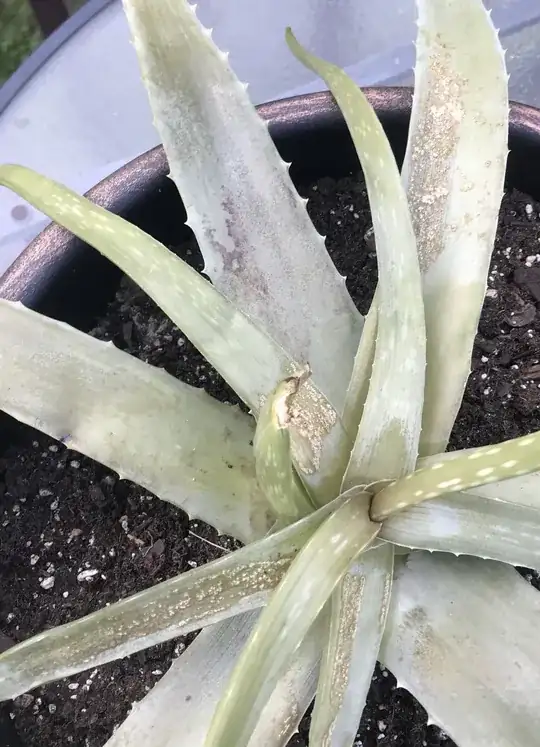I have absolutely no idea what’s wrong with my aloe. It started getting these patches of light brown spots a few weeks ago and appears to have spread. Any advice on what it is/how to treat it?

-
Anthony have you ever given this plant any balanced fertilizer? – stormy Jun 12 '18 at 01:38
-
I'm curious about the white scaly deposits on some of the leaves - do they come off if you scrape them? How long have they been there and is there anything underneath the leaves as well? Otherwise, has this plant been overwatered, or left standing in water in a saucer or outer pot? – Bamboo Jun 12 '18 at 11:24
1 Answers
This looks like it has the potential to be a bug; on the other hand, if you are over watering your aloe plant, it has the potential to be a fungus of some sort, or just a natural reaction to over watering, I have seen all three. Whenever I come across a problem like you are having here, this is the approach I follow. If the plant is outside, bring it inside and stop watering it. Let the soil dry out completely. I water my Aloe once a month so start to go light on the watering. If the plant starts to green up then we know it was over watering. However, a lot of problems can be a combination of issues such as bugs, soil and over watering. For the time being, I say your soil looks fairly decent. Now onto the treatment for bugs and fungi. I'm cautious to give you a definite answe, but we can still treat the plant.
Here are the steps to make an all in one pesticide for your succulent
1/4 gallon (4 cups) warm water
1/4 tablespoon neem oil (Kills bugs and fungi)
1/2 teaspoon 7.8% potassium silicate solution (Kills more bugs and fungi)
1/4 oz (1.5 teaspoons or 150 drops total) assorted essential oils - I use an even blend of ginger, rosemary, clove, and peppermint
1 tablespoon aloe vera juice
I wish you the best of luck. This treatment is best applied as a spray weekly depending on the environment the plant is being kept in. If it is inside then every 2 weeks should workout.
- 566
- 2
- 10
-
Are you meaning to suggest your mixture of ingredients should be applied as a spray, because that's not clear from your answer. If so, could you please edit the answer to make that clearer. – Bamboo Jun 12 '18 at 11:19
-
Sorry David...I was bad. Bringing a plant from the out of doors indoors without acclimation could kill, most likely will kill plants including Christmas trees, live trees in pots, if it was used to the sun and out of doors air. Neem is not a soil drench, so I am hoping you were thinking a spray. Potassium silicate does not 'kill' bugs and fungus. What it does do is make the plant a bit more hardy, thicker cell walls and the like. Plants when healthy are more resistant to bugs and disease. That is the silica part. The potassium needs to be taken into account when adding fertilizer, bal. – stormy Jun 12 '18 at 21:09
-
I have been on a dog gone rampage and I have to not comment when I am in a MOOD. I truly apologize, David. I was terribly out of line, huggs. I make a 'tea' or used to make a tea out of horsetail, full of silica to give plants a boost. We don't find horsetail around our locality. I don't like the potassium part because I already have potassium in my balanced fertilizer. Anyway, I'll go slink away, now...thanks Bamboo. Grins! – stormy Jun 12 '18 at 21:14
-
Stormy, you are absolutely correct and everything you say is perfectly valid so no need to apologize for your comments. In fact, you bring up very good points. By no means is my pesticide spray perfect but it is commonly used in some of the greenhouses I have visited to treat a variety of succulents. – David Wisniewski Jun 15 '18 at 00:39
-
As for the bring it inside part, I will add into my answer that it can be left to the owner to determine aloes are a very strong plant and for the most part should be able to cope with environmental changes. In my experience with aloes sometimes bringing them outside causes problems, so the first thing I recommend is to bring them inside. – David Wisniewski Jun 15 '18 at 00:39